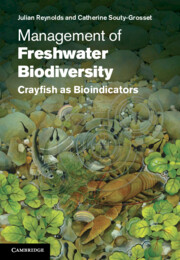Book contents
- Frontmatter
- Contents
- Preface
- Acknowledgements
- Introduction: Biodiversity in freshwater systems, and the key roles played by crayfish
- Part I The present situation of crayfish in world freshwater ecosystems
- Part II Applying science to conservation management
- A Protecting freshwater biodiversity through monitoring and conserving crayfish
- B Management for conservation
- 8 Control and management of non-indigenous crayfish
- 9 Biodiversity management through the reintroduction of heritage crayfish species
- Part III Knowledge transfer for successful crayfish management
- References
- Glossary
- Index
- Scientific and common English names of well-studied crayfish featured in this book
- Common English and scientific names of well-studied crayfish featured in this book
- Plate section
9 - Biodiversity management through the reintroduction of heritage crayfish species
from B - Management for conservation
Published online by Cambridge University Press: 05 December 2011
- Frontmatter
- Contents
- Preface
- Acknowledgements
- Introduction: Biodiversity in freshwater systems, and the key roles played by crayfish
- Part I The present situation of crayfish in world freshwater ecosystems
- Part II Applying science to conservation management
- A Protecting freshwater biodiversity through monitoring and conserving crayfish
- B Management for conservation
- 8 Control and management of non-indigenous crayfish
- 9 Biodiversity management through the reintroduction of heritage crayfish species
- Part III Knowledge transfer for successful crayfish management
- References
- Glossary
- Index
- Scientific and common English names of well-studied crayfish featured in this book
- Common English and scientific names of well-studied crayfish featured in this book
- Plate section
Summary
Introduction
Freshwater ecosystems, communities and populations can be managed in various ways, including controlled harvesting, restocking and habitat restoration. The restoration of habitats and communities may involve the reintroduction of keystone or heritage species which were formerly present. The principal aim of any reintroduction should be to establish a viable, free-ranging population of a species, subspecies or race which had become globally or locally extinct in the wild. It should be reintroduced within the species’ former natural habitat and range, and should require minimal long-term management. The objectives of reintroductions may include the enhancement of the long-term survival of a species, re-establishment of a keystone species (in the ecological or cultural sense) in an ecosystem, maintenance or restoration of natural biodiversity, provision of long-term economic benefits to the local and/or national economy, promotion of conservation awareness, or a combination of these objectives.
While in other regions of the world where crayfish are important, the situation is developing more slowly, in Europe there has been a drastic reduction in the distribution and abundance of the indigenous crayfish species (ICS), despite programmes of habitat restoration (Chapters 3 and 6). For example in Poitou-Charentes (France) successive surveys carried out from 1978 to 2003 revealed a high rate of disappearance of Austropotamobius pallipes populations from the region and the alarming spread of non-indigenous species such as Procambarus clarkii and Pacifastacus leniusculus. Represented by 137 populations in 1978, A. pallipes is now almost completely restricted to only one department, with just 45 populations recorded, representing a decrease of 68% of population numbers in 25 years and a loss of 40% of populations in the last 6 years (Bramard et al., 2006). This reflects the situation in the rest of Europe, as the IUCN is considering an overall rate of decline for European crayfish somewhere between 50% and 80% over the last 10 years (IUCN, 2009). This appears to be due to the direct and indirect results of human activities (e.g. destruction and fragmentation of habitats, pollution, poaching, and the introduction of invasive non-indigenous crayfish species (NICS), resulting in both competitive exclusion and dissemination of crayfish plague caused by Aphanomyces astaci). This disastrous situation led to the inception of the EC thematic network CRAYNET, which brought together scientists and water managers from 11 European countries. Reintroductions or restocking are often emphasized as a management strategy for the conservation of indigenous freshwater crayfish. Norway had especially good conditions for reintroduction of Astacus astacus after crayfish plague, because at the time there was no alien plague-carrying crayfish species in this country (Taugbøl, 2004a).
- Type
- Chapter
- Information
- Management of Freshwater BiodiversityCrayfish as Bioindicators, pp. 219 - 236Publisher: Cambridge University PressPrint publication year: 2011

